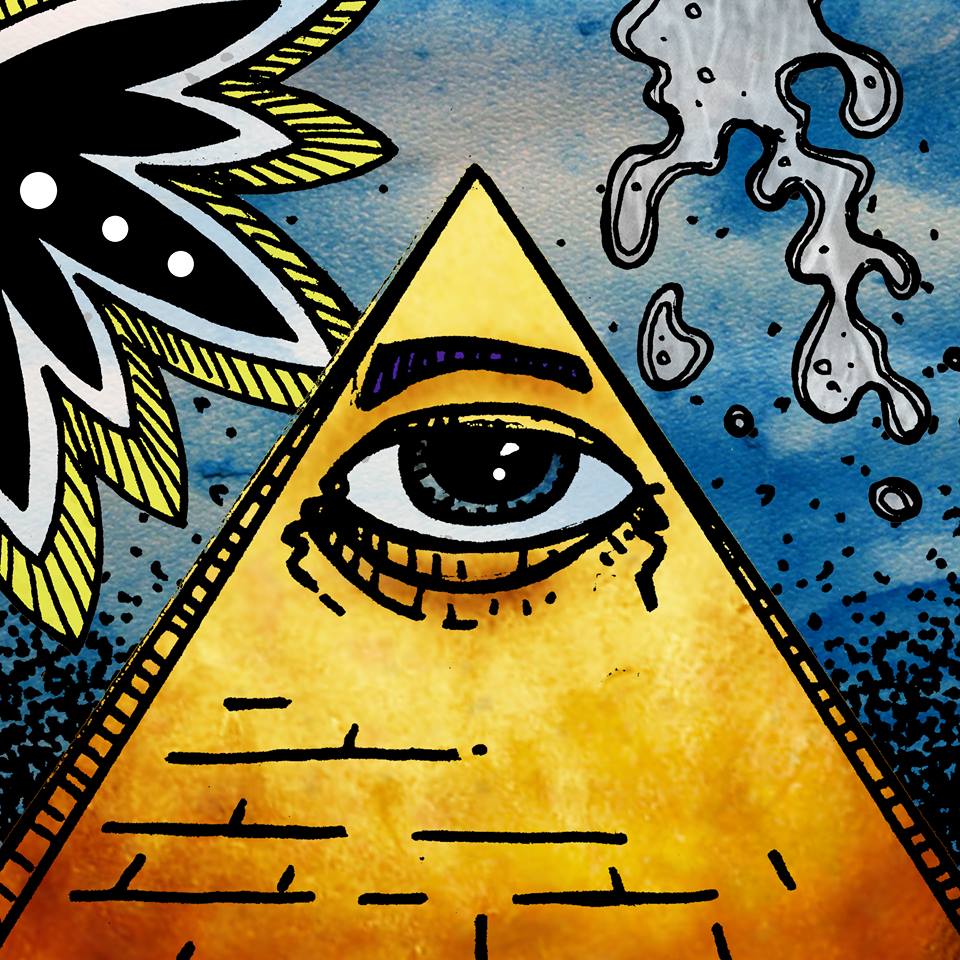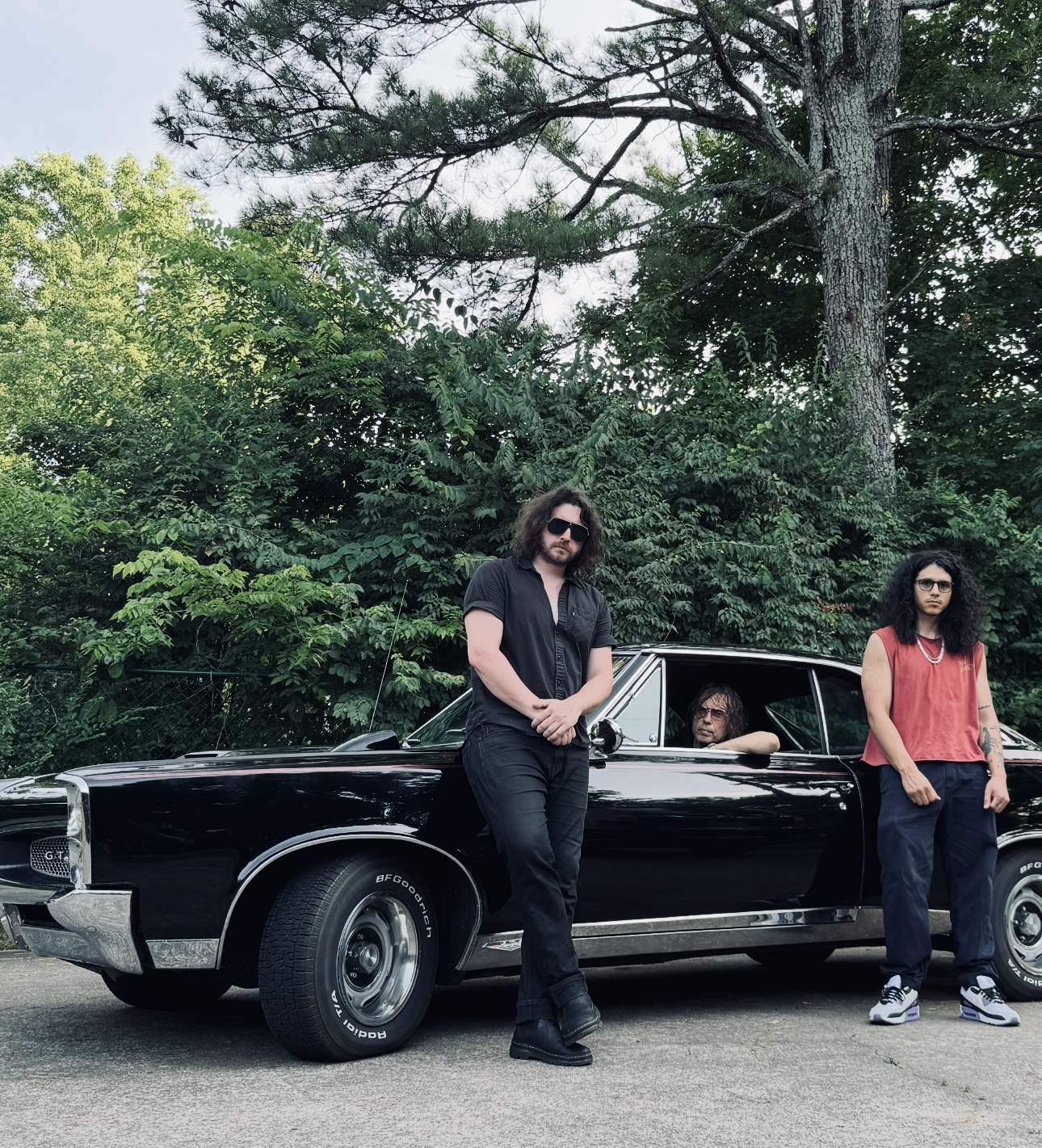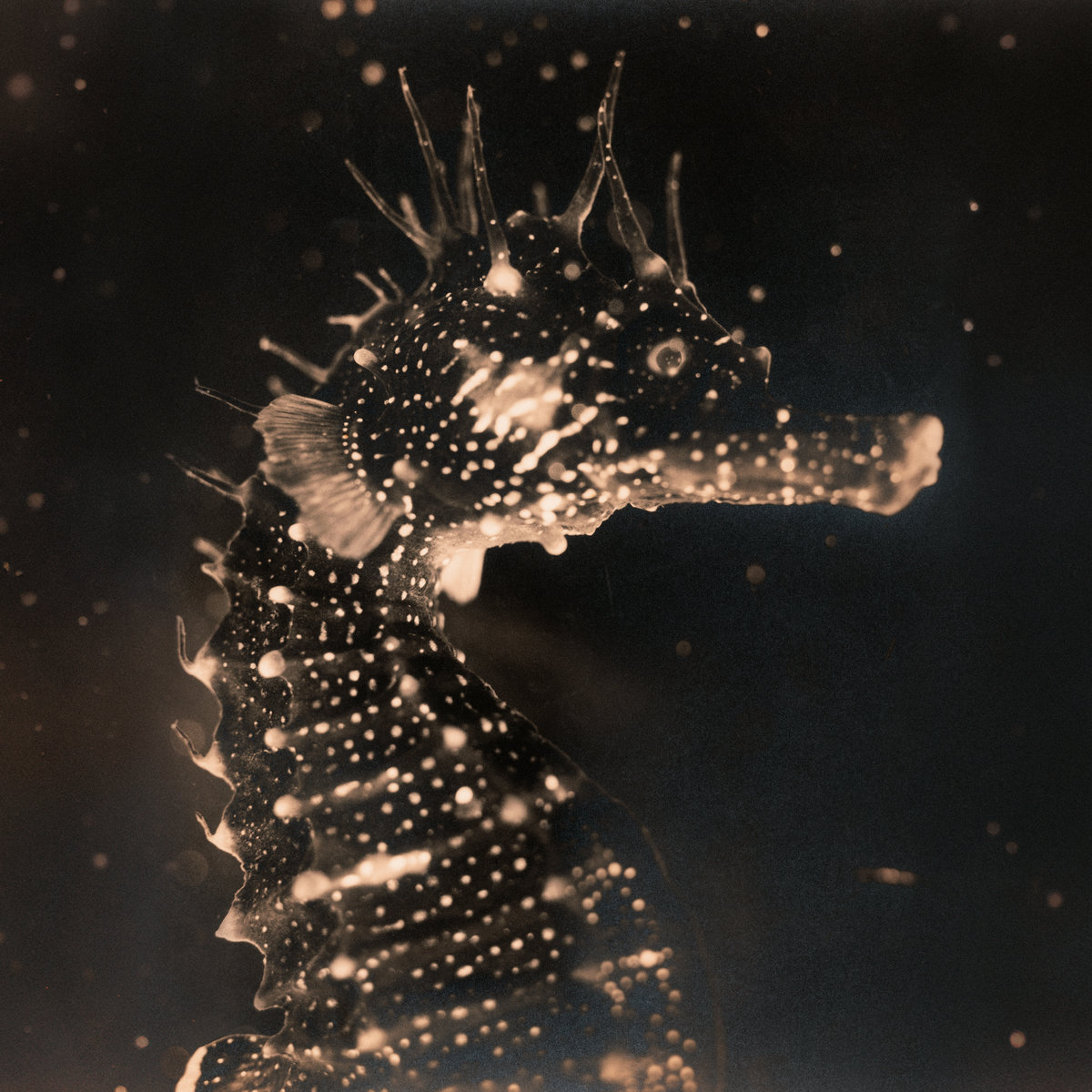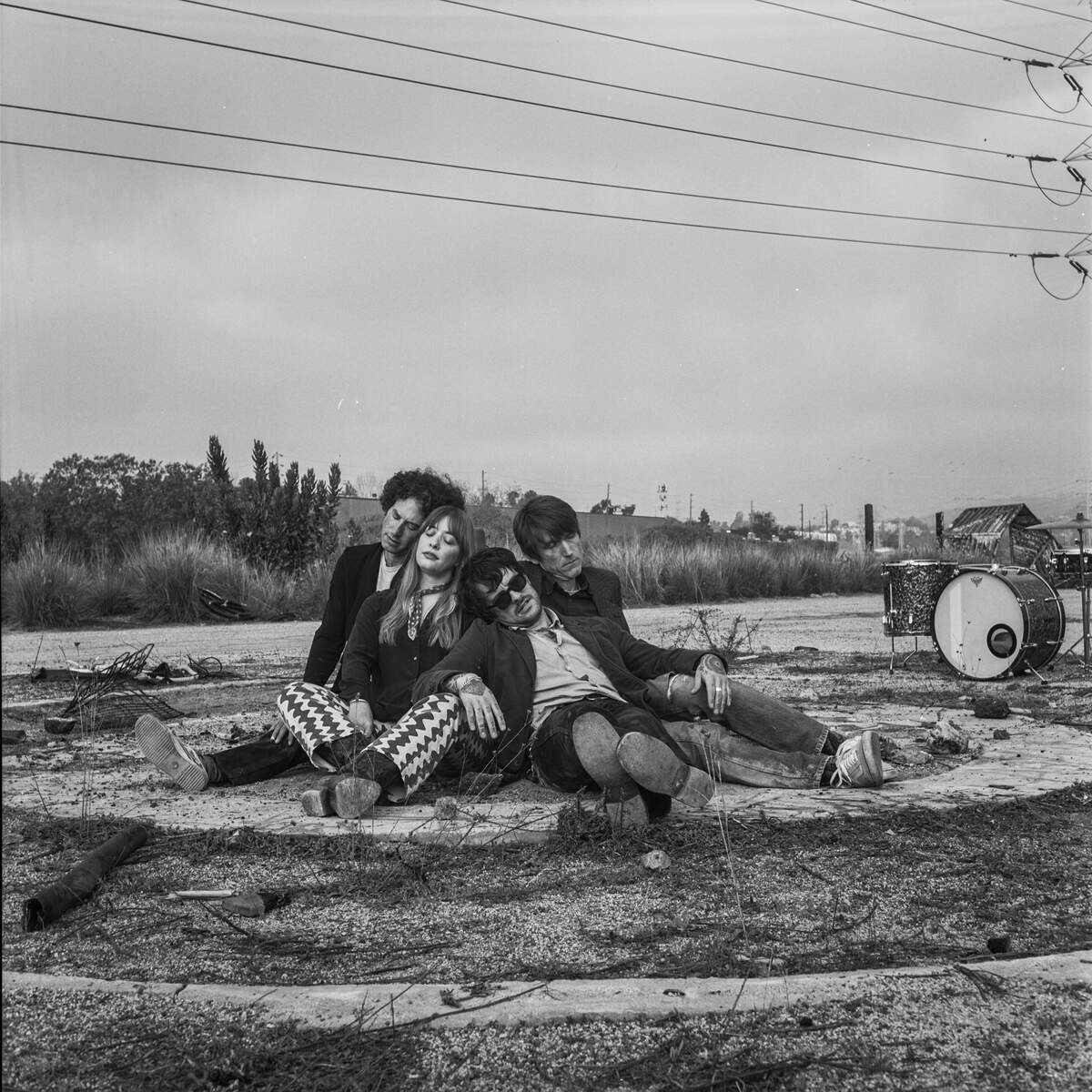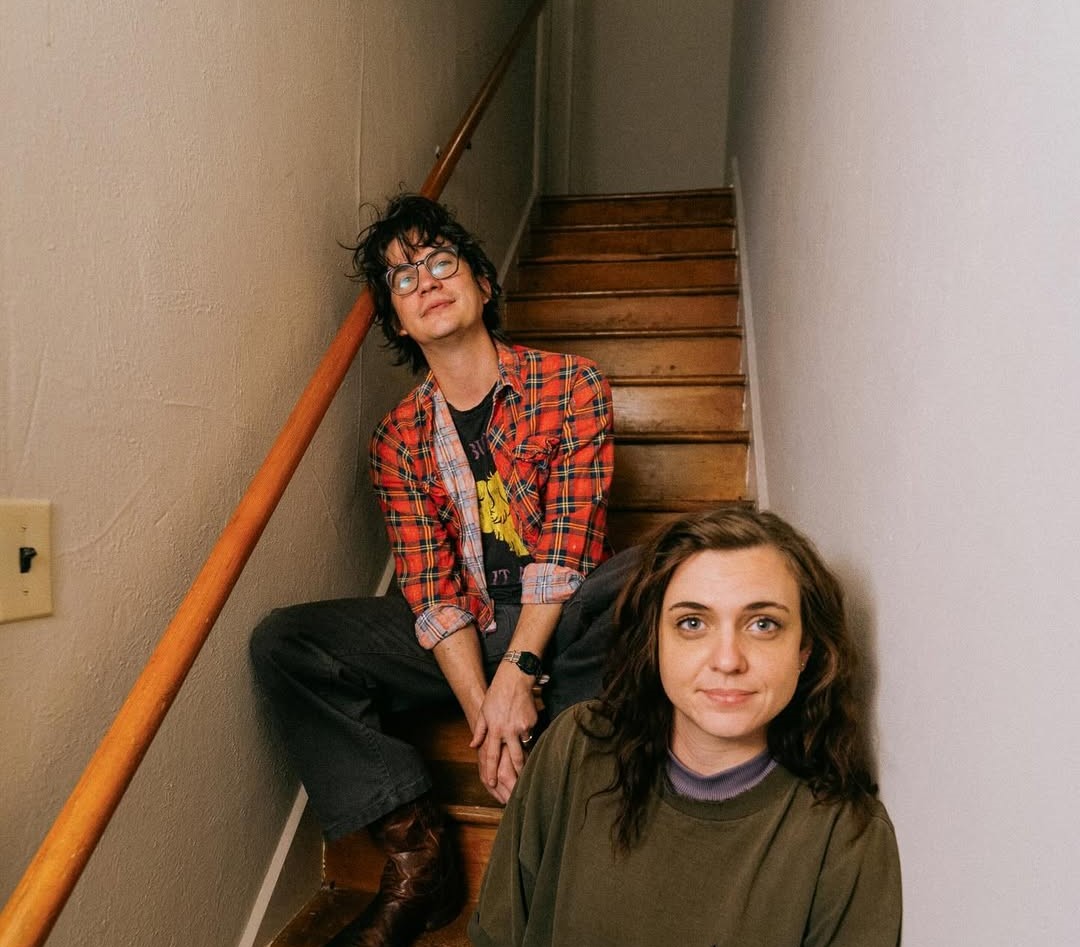Plugged In and Printed Out: Chet Weise on MAANTA RAAY and Third Man Books
MAANTA RAAY is an exciting new band that isn’t riding a retro psych wave or reviving garage fuzz clichés, but they’re into something far stranger and more electric, and that thing will be available June 27 on No Sabes label — and thankfully on vinyl for all eternity.
The project is heavily sedated with the spirit of cosmic rock, but its core is actually a pretty joyful communion that sparks from the interplay of musicians fully tuned into each other’s frequencies. Chet Weise, frontman and co-conspirator in this psych orbit, channels a kind of lightning only years in the underground could forge. From his days in the Immortal Lee County Killers to Kings of the Fking Sea, Weise has always found love in collaborations with a variety of musicians. MAANTA RAAY is no different. With Carlos Ortiz and Mason Hadley locking down rhythms, there’s a wild-eyed sense that anything can happen. And I guess it often does.
In the following interview we discuss MAANTA RAAY, its concept, as well, since he’s also behind the typewriter at Third Man Books, the publishing wing of Jack White’s Third Man Records empire. There, he helps cultivate literary voices with the same punk spirit that defined early fanzines and late-night tour van philosophizing. Third Man Books does what the big guys often won’t. It takes chances. It makes beautiful, physical books in an increasingly disposable world. The catalog is eclectic, but the throughline is clear: soul, vision, and guts. Weise sees books like he sees bands. They have to move you. They have to mean something. Whether it’s feedback or free verse, what matters most is connection. MAANTA RAAY howls it from amps. Third Man Books whispers it from the page. Both insist you feel it in your bones.

“We call it ‘bounded chaos.’ Within our tight songs, we let improvisation bring either joy… or terrible sorrow. And such is life.”
Your press notes mention “interstellar overdrive vs droned-out tempos” and something called “musi-quinox arrangements,” which is a phrase that honestly sounds like it could be either a deep-space jazz record or a lost Arthur C. Clarke manuscript, haha. There’s clearly this tug-of-war happening in your sound—between chaos and calm, motion and stillness. Can you talk about how that tension plays out when you’re writing? Are there moments on the debut where that friction really comes to a head? And when you’re chasing that feeling, what kind of world are you trying to build for the listener inside it?
Chet Weise: First, I gotta say you’ve already got me on a tangent with that Arthur C. Clarke reference! I love science fiction. One of my greatest fanboy bragging moments was having a poem published in The Magazine of Fantasy and Science Fiction. I also have a short essay about David Bowie’s ‘Space Oddity’ in there too. Being a fan of that magazine since I was a kid, I’m very happy to be in its pages, which is pretty obvious since I’m bringing it up first thing in this interview!
I love that you’ve picked up on the chaos versus calm in the RAAY’s music. Myself, Carlos, and Mason talk a lot about our music being “bounded chaos.” Our go-to arrangement is a tight song with lots of sections. Within some of those sections we encourage improvisation, and with improvisation can come great joy or terrible sorrow, when you play like shit! And such is life.
As a musician and writer, I very much try to mix chaos and order. If art is the imitation of reality, then chaos and calm is real life in art. People are always trying to make order out of chaos, then when life gets boring and too ordered, we tear something up and let the chaos follow.
On that note, the RAAY doesn’t take ourselves too seriously. We love Ace Frehley and Betty Davis Sci-Fi as much as we do Arthur C. Clarke and Carol Emschwiller SF/F. We really just love to blast riffs and get into a beat.
So, how did MAANTA RAAY actually come together? Was it one of those late-night jam sessions that turned into something real, or more like lightning struck and suddenly you had a new band?
The band did hatch from jam sessions. I had a few people come over to my house and we played for hours. In the yard behind my rehearsal room, there’s a treehouse. We took a break to go up there and smoke. We all liked what was happening and decided to jam again another time. We did, and then we decided to jam again, and this time we decided to start a band.
We did that. Carlos and I wanted to write songs. And so we named the band MAANTA RAAY and evolved into having goals and band rehearsals rather than jams. When that all fired up, we had quite a few band member changes. That happens with bands like ours. People have lives and schedules, and also other bands that they’re committed to.
So we began as a quintet (had an organ player for a few months!) but we’re a trio now. When Mason joined on bass, that’s when the group solidified.
You’ve name-checked some pretty wild influences: Leigh Stephens (Blue Cheer), Jaki Liebezeit (CAN), Daphne Oram, Randy Rhoads, James Jamerson, Ron Asheton. It’s like this cosmic grab-bag of proto-metal, krautrock, early electronic weirdness, funk, and heavy guitar. How do all those threads actually come together in the world of MAANTA RAAY? Are you consciously pulling little fragments from each, or is it more of an instinctual stew? Is there a moment on the record, a riff, a beat, some strange texture where you can hear one of those ghosts most clearly?
Oram is definitely in the ambient sounds and creases in the record. Asheton is the wah-wah pedal fuzzed noise explosions. Stephens and Randy are in almost all the solos. From the proto-metal, Hendrix-ian licks of Stephens to the sense of melody and rhythm of Rhoads, I just love it and love making that stew part of my own.
I think the solos in our songs ‘Night Rider’ and ‘UFOrchid’ definitely show that stew. CAN and Jamerson are embedded in our rhythm section. Carlos and Mason could have tried out for Motown’s Wrecking Crew back in the day if they had wanted, and then freaked out with CAN or Amon Düül II.
Given your background in bands like The Quadrajets and Immortal Lee County Killers, what was the energy like in those days? Any stories that still stick with you or shaped how you approach music now?
Oh God, this is a big question. I don’t want to switch into rock and roll soldier veteran story mode and drone on about this or that back then… so much happened.
The ‘Jets and ‘Killers were amazing dudes and bands. Both groups started in a kitchen or on a back porch in Alabama and somehow toured the USA, Europe, UK, Japan, and Australia. We had no idea what we were doing, but we did it anyhow.
I think that’s what I learned from those days. Sometimes the most important ingredient for a band is sheer willpower. Probably the other lesson I learned is that in many cases it’s best to let a band evolve into itself, to play according to the group’s strong points and flow with the creative tug-of-war that always happens.
Living in Auburn, Alabama, at the time, there were great musicians but not for-hire professional musicians. So I could not just say I want to start THIS or THAT kind of band and you’re on the payroll. We could only put together a group of guys that could coexist in a van on tour and had a rough sketch of what we wanted to try. Then we evolved into a sound. I loved that evolution.
One thing about the Quadrajets, though, I’ve never been stopped and searched in my life more by the cops. We drove a customized, airbrushed Chevy hot rod van called The Captain. Once we stopped at a McDonald’s on our way to New York around 2 a.m. The only people inside were two police officers. We finished eating, got in The Captain, and drove off. About ten minutes later, those same two cops from McDonald’s pulled us over and searched the van.
Of all the crazy shit that happened to us, that moment remains vivid. The idea of them eating McNuggets as they watched us pull away, and then agreeing to go get us. They had to have had that conversation.
After the Quadrajets, when the Lee County Killers started touring, we bought a minivan and put an indescript soccer ball magnet on the back door. Never got pulled over once. Live and learn.
If you had to boil it down, what’s the core sound or vibe you’re chasing with MAANTA RAAY? Like, what’s the mission, sonically? And is there a track on the debut where you feel like, yeah, that’s the blueprint, that’s the sound fully realized?
I think both ‘Night Rider’ and ‘MAANTA RAAY Theme’ sum up the RAAY at this point. I think the band’s mission statement is probably orbiting around a good riff and a beat. I layer a lot of fuzz pedals, use effects in my own way, and let my Stratocaster help me write lyrics and bridges. Carlos and Mason are who really arrange the songs. It’s their beats and organization that turn the noise into something legible to rock.
We’re not a silent tree in the forest kind of band. We do want people to hear and connect with us. That’s what we love, creating a vibe. That’s the real challenge these days, to take up fuzz pedals, guitars, drums, and bass, and do something new but still connect with our past too.
Man, there have been a lot of power trios at this point in history. No one is going to outdo the Jimi Hendrix Experience at their game, or even Nirvana at theirs. But we love drums, guitar, and bass, so we love power trios and the limited limitlessness of that lineup. Our challenge is to play riffs that are different from Blue Cheer, Truth and Janey, all those great bands, and all of our contemporaries.
For me, the easy way out is to introduce some new instrument via computer or programming, but many of those “new” sounds turn out to be novelties and get dated quick. I’m lucky to be old enough to have seen Hip Hop flourish. That was a genuine new sound, a genuine revolution.
We’re trying to get somewhere new, not by novelty, but via different ways of using notes, arrangements, tones, lyrics, that connect with here and now, but also connect with all the music we grew up loving. There’s an ambient sound interlude on our record called “Ancient Future.” In a way, that title is our modus operandi—to create music that feels like it’s always been here, but always sounds new.
There’s a sample in that interlude about a theory that extraterrestrials aren’t unknown lifeforms, but are our future selves time traveling back and forth between now, then, and tomorrow. I like to think of my favorite music as one of those time traveling beings. The songs exist everywhere and with anyone.
The band name, MAANTA RAAY, itself feels somewhat mysterious. Does it hold a specific meaning?
Manta rays are the most psychedelic and mysterious creatures. They look like starships from another world and are menacing as hell in an underwater War of the Worlds sort of way, but they are from Earth and are actually very peaceful. That’s all just awesome. So much to learn from that.
But then, for a band name, of course there are already bands who named themselves Manta Ray, so naturally, haha, we added a bunch of “A”s. Written in all caps, I think it looks visually sort of trippy.
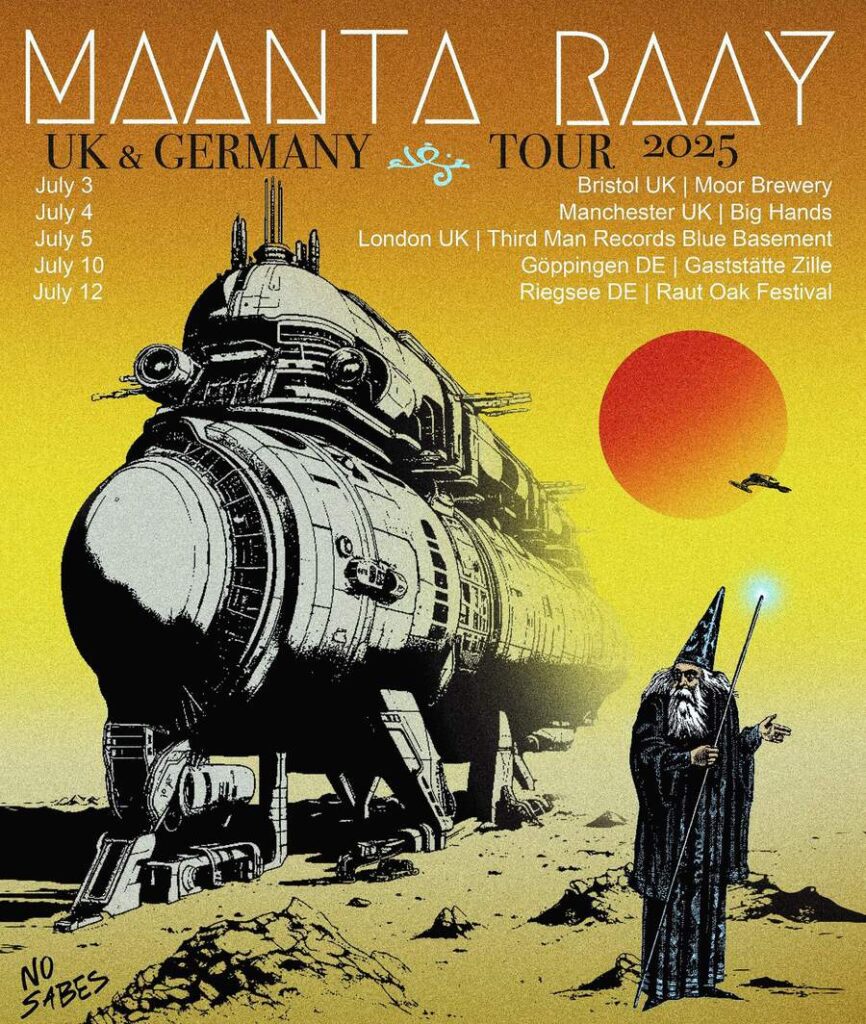
You’ve shared bills with some impressive bands: Earthless, Boris, Minami Deutsch, Melvins, Napalm Death. That’s a wild lineup. What was it like being in that mix? Any moments from those shows that really stuck with you or pushed you in some new direction?
All great bands and people who either have created history or are creating history. It was just great to be in the same space with them. Such a good time to be had!
They’re all so different, but because freaks of a feather flock together, it feels right that we’re all playing with one another and in the same venues, sharing much of the same audiences. Music lovers gonna love music!
It’s been a while since Kings of the Fking Sea released music. When you look back on that chapter now, what do you think really defined the band? Like, what was the core spirit or driving force behind it all, the thing that made it Kings?
Sara Nelson and Maria “Poni” Silver made that band. Sara played in the Little Killers back in the day and Poni with The Ettes. They are good friends and a tight-as-hell rhythm section. They are both rock and roll inside and out.
They are both independent businesspersons running their own things, so they both got so busy, it became hard to do the band. Such is life. I’m also Poni’s husband. (Believe me, I know that I married up.)
One night I was sort of bumming out because I wanted to play more shows. She looked at me and said, “Chet, you live in Nashville. All your friends play music. Just start a new band.” She said that in the most matter-of-fact yet loving way. I just said, ok, you’re right.
Whenever Sara and Poni decide it’s time, KOTFS shall roll again!
The transition from Kings of the Fking Sea to the more expansive, psych-tinged sound of MAANTA RAAY is quite a change for you. Were there elements or lessons learned from your time with Kings of the Fking Sea that you consciously carried forward into the creation of MAANTA RAAY, perhaps in terms of songwriting or even just the pure joy of collaborative creation?
I think this goes back to what I was talking about with the Qjets and Lee County Killers. I like to connect with the other members of the band and use each other’s strengths and energies. It’s sort of like taking electricity and shaping it into something like a lightning bolt, laser light show, heater, porch lamp, city skyline, etc. Carlos and Mason bring a different electricity than Poni and Sara. I respond to that.
Also, weirdly, I realized for the first time the deep sea connection between the two band names. Kings of the F-King Sea (named after a book of poems by Dan Boehl) and MAANTA RAAY. I guess there’s something about the ocean. It is a big, beautiful, powerful, unknown universe unto itself.
“Books, movies, music, art—it all goes together. Crashing after a gig usually means sleeping next to a bookshelf, a record player, and a cat.”
You’ve done some seriously cool work with Third Man Books—shining a light on voices that don’t always get their due. What pulled you into that world in the first place? Was there a moment where it just clicked, like yeah, this is something I need to be part of? What lit the fire for you when it comes to championing these kinds of stories and voices?
Ahh, nice turn of questioning! I must switch from band dude to writer and editor now. But there really isn’t that much of a difference. I’ve found from touring in all my bands that it’s pretty likely when I crash that night after a show at someone’s house, I’ll probably find a spot in a room with their cat and a bookshelf of incredible books, probably watch an amazing movie in the late hours with them, and then browse through their extensive record collection, finding all sorts of new music. I mean, you mentioned Arthur C. Clarke in the first question of this interview, so you know what I’m talking about. Books, movies, music, art, it all goes together.
As far as my job specifically, the Immortal Lee County Killers shared bills or ran around in the same scenes as White Stripes, Soledad Brothers, and Dirtbombs. Jack White, Ben Swank, and Ben Blackwell were all at the beginning of Third Man Records. I came along and they added Third Man Books. TMB tries to find great writing that the big publishers haven’t found yet or might not want to take the chance on. We’ll take that chance.
The hardest part of my job, though, is all the books that we can’t publish. We only release four to six books per year. That’s about all that we can responsibly publish into the world. I wish we could publish all the books we wanted to. Unfortunately, I have to say “no” to way more excellent books than I can say “yes.” That’s a drag.
Third Man Records, and by extension Third Man Books, has always championed a certain DIY philosophy… commitment to tangible, often beautifully crafted physical artifacts. How does this philosophy translate into your work at Third Man Books, particularly in an increasingly digital literary landscape? Are there specific design or publishing choices made for Third Man Books titles that reflect this commitment to the physical object and its inherent value?
Jack, Swank, Blackwell, and myself came up in the DIY music scene. That’s all we know. Everything else we’ve learned on demand because we had to. We don’t know any other way to operate. Largely because of that, TMR and TMB have a certain aesthetic. In a way, we’re still all going to Kinko’s late at night to make our own flyers by hand or staple the latest fanzine together.
Third Man has this serious DIY edge to it… like a real love for the physical, tangible stuff that feels handcrafted in a world going all digital. How does that attitude shape what you do at Third Man Books? Are there moments where the design or the way you put a book together really speaks to that commitment to making something you want to hold, something with soul?
First, to stay relevant, we have to respect how digital is changing the landscape. We’re not luddites. What we do is continue to love and respect the tangible. I think that’s vital to a healthy world. Let’s not forget that humans are still much more complex than the most capable AI or smart computer. We live in messy, sweaty, bleeding, crying, laughing, incredibly smart and powerful bodies. Flesh, blood, and thought is what makes up our lives. It’s physical. In the wonderfully eternal words of Olivia Newton John, “Let’s get physical.” And realize we do need to live in our bodies. We are physical beings. We need touch.
You’ve published a diverse range of authors and works through Third Man Books. Is there a unifying thread or a particular aesthetic that you look for when considering new projects or authors? What makes a manuscript or a concept “Third Man Books material” in your eyes? Could you share an anecdote about a particularly challenging or rewarding project you’ve worked on with Third Man Books?
Good writing is the main ingredient. We publish history, fiction, speculative fiction, SF and F, and music books. Along with good writing, I look for books that I think will stay relevant for all time. Timeless writing isn’t rare. There’s a lot of great poems and stories being made today that someone two hundred years from now will love.
Did you know there were only around ten copies of William Blake’s Songs of Innocence and Experience? Now Blake is in almost every school book. Johnny Depp even played him (sort of) in a Jim Jarmusch movie. I mean, that’s as good as a Nobel Prize, right? But my point is that books are like temples and mountains or memories. They last forever and end up doing the craziest things.
You’re deep into both music and books. How do those two worlds talk to each other for you? Does your sense of rhythm or song structure sneak into how you pick or appreciate the writing you publish? Or maybe the other way around?
Writing poetry has very much changed my songwriting. Maybe surprisingly, not really for the lyrics either. Writing a poem really makes you think about economy of word (like musical notes), when to make a poem long (stretch out a song section, improvise in parts sort of like writing stream of consciousness), or sometimes it’s best to keep a poem short (tight structure and arrangements are the hallmark of many hit songs, like Sabbath’s “Paranoid” was one of their first pop-ish songs). And in poetry the tools of tone, cadence, and rhythm are all vital to a poem (but sometimes taken for granted by bands).
MAANTA RAAY has worked hard on our general tone as a band. Most of all, poetry has taught me about engaging with an audience. I’ve written so many poems that someone will say, “Lots of good imagery, but I don’t get it.” I’m also not saying here that everything has to have meaning. But I do want everything to vibe. To connect somehow. With a lot of poetry you might not walk away knowing exactly what the poem was specifically about, but you still get it. You still know what it was really about, even if you don’t understand every detail.
I want my tree in the forest to be heard when it falls, and for people to get what it meant to me. I don’t want it to be lost in the other trees, and I don’t want it to be alone. That’s why I play a 100-watt Marshall through two 4×12 cabs and follow the lead of Carlos and Mason’s interstellar driving rhythm. We’re going to be heard, one way or another.
With the MAANTA RAAY album coming soon and a tour on deck, what’s on your mind for this next chapter? What do you want people to feel or take with them after hearing the record or catching you live? Any cities or venues you’re especially pumped to hit, and why those spots?
We’re already writing and thinking about the next record. I hope that when people hear this record, that they’ll be as excited for the next as we are.
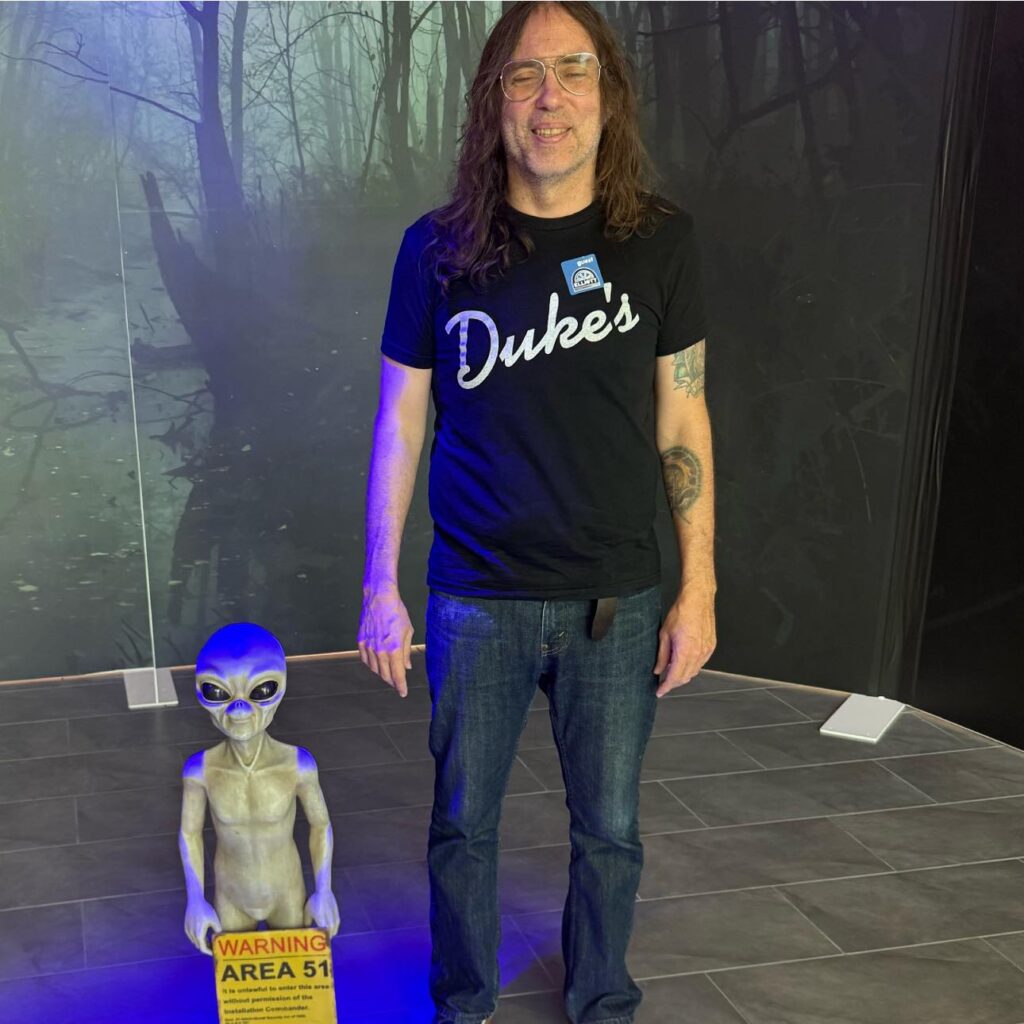
Alright, Chet, imagine this— you roll through my town, stop by my place for a late-night crate dig on the turntable. What five records do you reach for to blow my mind? I want the deep cuts, the weird stuff, the things that get your heart racing and your motor revving.
‘Ecstatic Music of the Jemma EL FNA’
‘Illuminations’ – Alice Coltrane and Santana
‘Live at Last’ – Black Sabbath (found this in the one-dollar cassette bin during high school)
‘PSF Psychedelic Sampler’
‘If You Miss ‘Im… I Got ‘Im’ – John Lee Hooker
Klemen Breznikar
Headline photo: Poni Silver
MAANTA RAAY Instagram / Bandcamp
No Sabes Website / Instagram / Bandcamp
